The Cambridge History of China. Vol. 06. Alien Regimes and Border States, 907-1368
Подождите немного. Документ загружается.


HOUSEHOLDS IN BONDAGE 663
applied a different system, the two-tax system inherited from the Sung
dynasty, in the south. This is evidence of both the government's realistic
flexibility and its administrative weakness. That weakness, obvious to all,
encouraged the abuses of landlordism and truancy throughout China, but
particularly in the richer southern provinces. The economic circumstances of
rural China remained poor. Under Khubilai some gains were made in agricul-
tural rehabilitation but were again lost under his weaker successors. This is
attested in various ways, particularly by the many references in contemporary
documents to large numbers of migrant people (//» miri).
6
'
One other window on this aspect of Yiian history is opened by the exten-
sive accounts of popular religion and the associated rebellious movements
during the late Yiian. Messianic doctrines, remotely Manichean in deriva-
tion, predicted the imminent triumph of the Buddha Maitreya who would
appear at the moment the world reached its darkest and its people were the
most desperate. Millions of rural Chinese, mostly from north of the Yangtze
River, were persuaded to believe that the world of mid-fourteenth-century
Yiian China was on the verge of descending to that nadir and that therefore it
soon would be transformed into golden, blissful radiance once again. Para-
dise would be realized on earth.
One implication of such doctrines' success is that rural life was indeed very
harsh, lending credibility to the idea that the worst had been attained and
that its sudden reversal was at hand. This idea made masses of the ordinary
people susceptible to a leadership claiming some affinity with the Buddha
Maitreya, and many such leaders so portrayed themselves. Another implica-
tion is that the traditional Confucian-minded elite, even though their pres-
tige in the eyes of society remained intact, could nonetheless exert only a
weakened local leadership, so that large numbers of ordinary people were less
subject to elite normative influences. One feature of the late Yiian rebellions
is that the elite most commonly sided with the government in its ineffectual
suppression of the sectarian revolts. Other purely secular rebellions of the
desperate farming population also arose in great number, many of them
starting as no more than movements of community self-defense against ban-
ditry that the government was unable to suppress. Study of the fourteenth-
century rebellions has progressed greatly in recent years, a synthesis that will
reveal the contours of rural society more fully and describe the actual condi-
tions of daily life may soon be at hand.
66
65 Ch'iu Shu-shen and Wang Ting, "Yiian tai hu k'ou wen t'i ch'u i," pp. 116—18.
66 See Chapter 7 in this volume and also my discussion of the popular rebellions leading to the founding
of the Ming dynasty in "The rise of the Ming dynasty, 1330—1350," in
The
Ming
dynasty,
1368—1644,
pt. 1, vol. 7 of The Cambridge history of China, ed. Frederick W. Mote and Denis C. Twitchett
(Cambridge, 1988), pp. 11-57, *sp- PP-
I2
~43-

664 CHINESE SOCIETY UNDER MONGOL RULE
We must return to the point with which this chapter opened: We face the
dilemma of being unable to state how many people - within the largest
tolerable margins of error - inhabited China in Yuan times or of knowing
how to account for the large decreases indicated by the difficult-to-interpret
figures available to us. As long as the answers to a question of such basic
importance are still not within our grasp, we can at best raise other questions
about the entire range of historical issues, survey the recent scholarship to
which it is relevant, and propose summary statements of limited, temporary
usefulness. Yuan history intrigues us because there seems to have existed in
that important segment of time a conjunction of influences, of currents
making for social change, that might be expected to possess great explana-
tory value for our understanding of Chinese history.
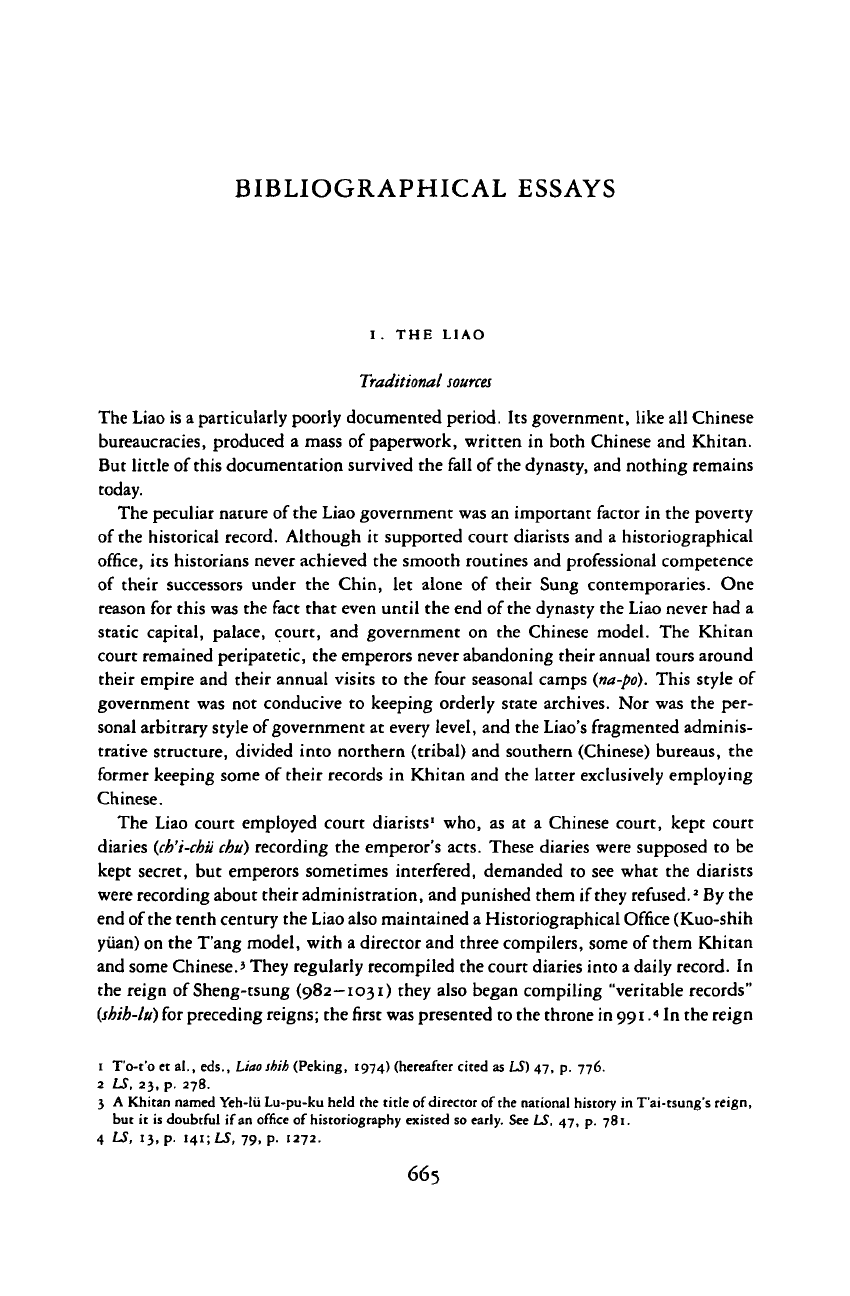
BIBLIOGRAPHICAL ESSAYS
I. THE LIAO
Traditional
sources
The Liao is
a
particularly poorly documented period. Its government, like all Chinese
bureaucracies, produced a mass of paperwork, written in both Chinese and Khitan.
But little of
this
documentation survived the fall of the dynasty, and nothing remains
today.
The peculiar nature of
the
Liao government was an important factor in the poverty
of the historical record. Although it supported court diarists and a historiographical
office, its historians never achieved the smooth routines and professional competence
of their successors under the Chin, let alone of their Sung contemporaries. One
reason for this was the fact that even until the end of
the
dynasty the Liao never had a
static capital, palace, court, and government on the Chinese model. The Khitan
court remained peripatetic, the emperors never abandoning their annual tours around
their empire and their annual visits to the four seasonal camps
(na-po).
This style of
government was not conducive to keeping orderly state archives. Nor was the per-
sonal arbitrary style of government at every level, and the Liao's fragmented adminis-
trative structure, divided into northern (tribal) and southern (Chinese) bureaus, the
former keeping some of their records in Khitan and the latter exclusively employing
Chinese.
The Liao court employed court diarists
1
who, as at a Chinese court, kept court
diaries
{ch'i-chii chu)
recording the emperor's acts. These diaries were supposed to be
kept secret, but emperors sometimes interfered, demanded to see what the diarists
were recording about their administration, and punished them if they refused.
2
By the
end of the tenth century the
Liao also
maintained
a
Historiographical Office (Kuo-shih
yuan) on the T'ang model, with a director and three compilers, some of them Khitan
and some Chinese.' They regularly recompiled the court diaries into
a
daily record. In
the reign of Sheng-tsung (982—1031) they also began compiling "veritable records"
(shih-lu)
for preceding reigns; the
first
was presented to the throne in 991.«In the reign
1
T'o-t'o
et al., eds., Liao sbih (Peking, 1974) (hereafter cited as IS) 47, p. 776.
2 LS, 23, p. 278.
3 A Khitan named Yeh-lii Lu-pu-ku held the title of director of the national history in T'ai-tsung's reign,
but it is doubtful if
an
office of historiography existed so early. See LS, 47, p. 781.
4 LS, 13, p.
141;
LS, 79, p. 1272.
665
Cambridge Histories Online © Cambridge University Press, 2008
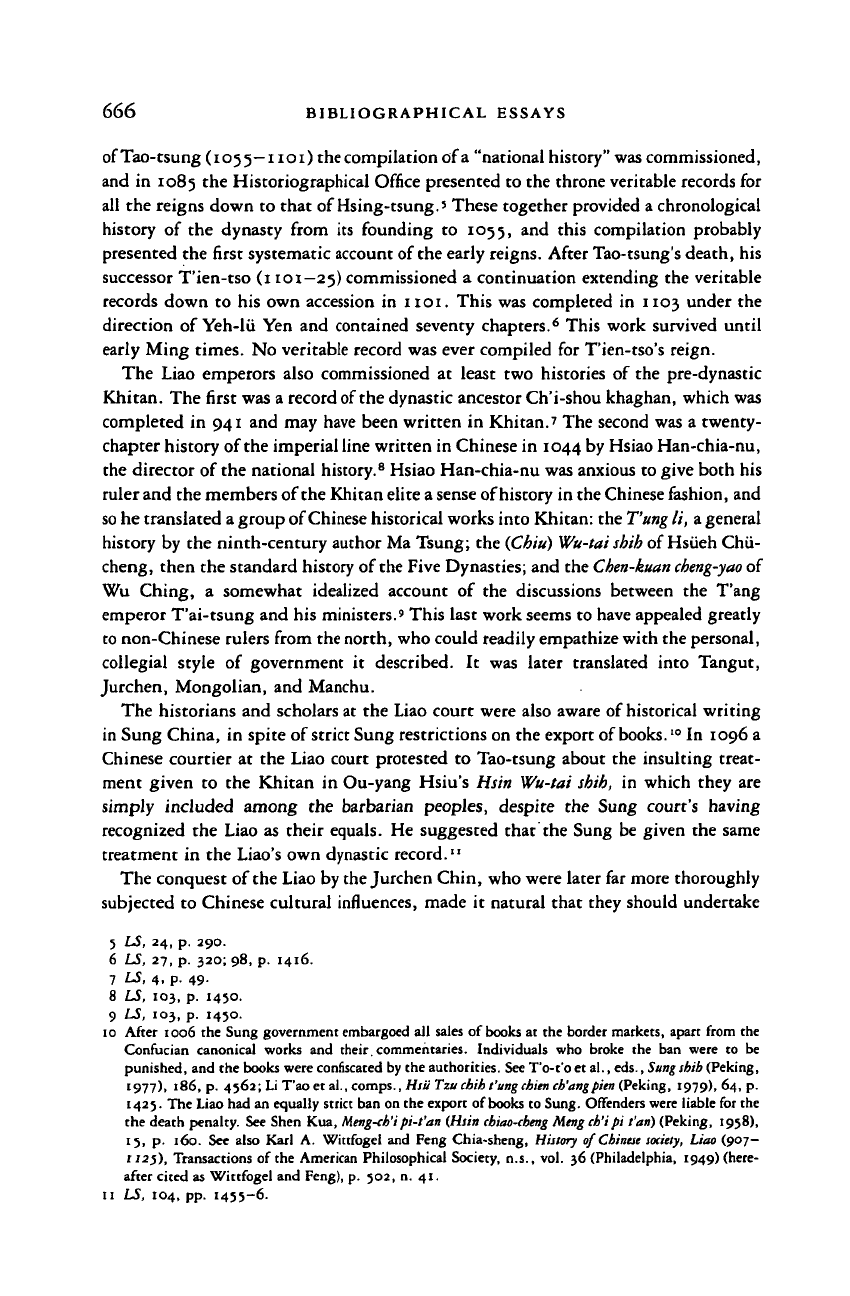
666 BIBLIOGRAPHICAL ESSAYS
ofTao-tsung
(1055—IIOI)
the compilation of a "national history" was commissioned,
and in 1085 the Historiographical Office presented to the throne veritable records for
all the reigns down to that of Hsing-tsung.' These together provided a chronological
history of the dynasty from its founding to 1055, and this compilation probably
presented the first systematic account of the early reigns. After Tao-tsung's death, his
successor T'ien-tso (1101—25) commissioned a continuation extending the veritable
records down to his own accession in 1101. This was completed in 1103 under the
direction of Yeh-lii Yen and contained seventy chapters.
6
This work survived until
early Ming times. No veritable record was ever compiled for T'ien-tso's reign.
The Liao emperors also commissioned at least two histories of the pre-dynastic
Khitan. The first was a record of the dynastic ancestor Ch'i-shou khaghan, which was
completed in 941 and may have been written in Khitan.' The second was a twenty-
chapter history of the imperial line written in Chinese in 1044 by Hsiao Han-chia-nu,
the director of the national history.
8
Hsiao Han-chia-nu was anxious to give both his
ruler and the members of the Khitan elite
a
sense of history in the Chinese fashion, and
so
he translated
a
group of Chinese historical works into Khitan: the Tung
li,
a
general
history by the ninth-century author Ma Tsung; the
(Chili) Wu-tai shih
of Hsiieh Chii-
cheng, then the standard history of
the
Five Dynasties; and the
Chen-kuan cheng-yao
of
Wu Ching, a somewhat idealized account of the discussions between the T'ang
emperor T'ai-tsung and his ministers.
9
This last work seems to have appealed greatly
to non-Chinese rulers from the north, who could readily empathize with the personal,
collegial style of government it described. It was later translated into Tangut,
Jurchen, Mongolian, and Manchu.
The historians and scholars at the Liao court were also aware of historical writing
in Sung China, in spite of strict Sung restrictions on the export of
books.
10
In 1096 a
Chinese courtier at the Liao court protested to Tao-tsung about the insulting treat-
ment given to the Khitan in Ou-yang Hsiu's Hsin Wu-tai
shih,
in which they are
simply included among the barbarian peoples, despite the Sung court's having
recognized the Liao as their equals. He suggested that the Sung be given the same
treatment in the Liao's own dynastic record."
The conquest of the Liao by the Jurchen Chin, who were later far more thoroughly
subjected to Chinese cultural influences, made it natural that they should undertake
5 LS, 24, p. 290.
6 LS, 27, p. 320; 98, p. 1416.
7 LS, 4, p. 49.
8 LS, 103, p. 1450.
9 LS, 103, p. 1450.
10 After 1006 the Sung government embargoed all sales of books at the border markets, apart from the
Confucian canonical works and their, commentaries. Individuals who broke the ban were to be
punished, and the books were confiscated by the authorities. See
T'o-t'o
et al., eds.,
Sung
shib (Peking,
1977),
186, p. 4)62; Li T'ao et al., comps.,Hsu Tzucbiht'ungchiench'angpien (Peking, 1979), 64, p.
1423.
The Liao had an equally strict ban on the export of books to Sung. Offenders were liable for the
the death penalty. See Shen Kua,
lAmg-ch'i
pi-t'an (Hsin
cbiao-cbeng
Meng ch'ipi I'an) (Peking, 1958),
15,
p. 160. See also Karl A. Wittfogel and Feng Chia-sheng, History of
Chinese
society,
Liao (907-
1125),
Transactions of the American Philosophical Society, n.s., vol. 36 (Philadelphia, 1949) (here-
after cited as Wittfogel and Feng), p. 302, n. 41.
11 LS, 104, pp. 1455—6.
Cambridge Histories Online © Cambridge University Press, 2008
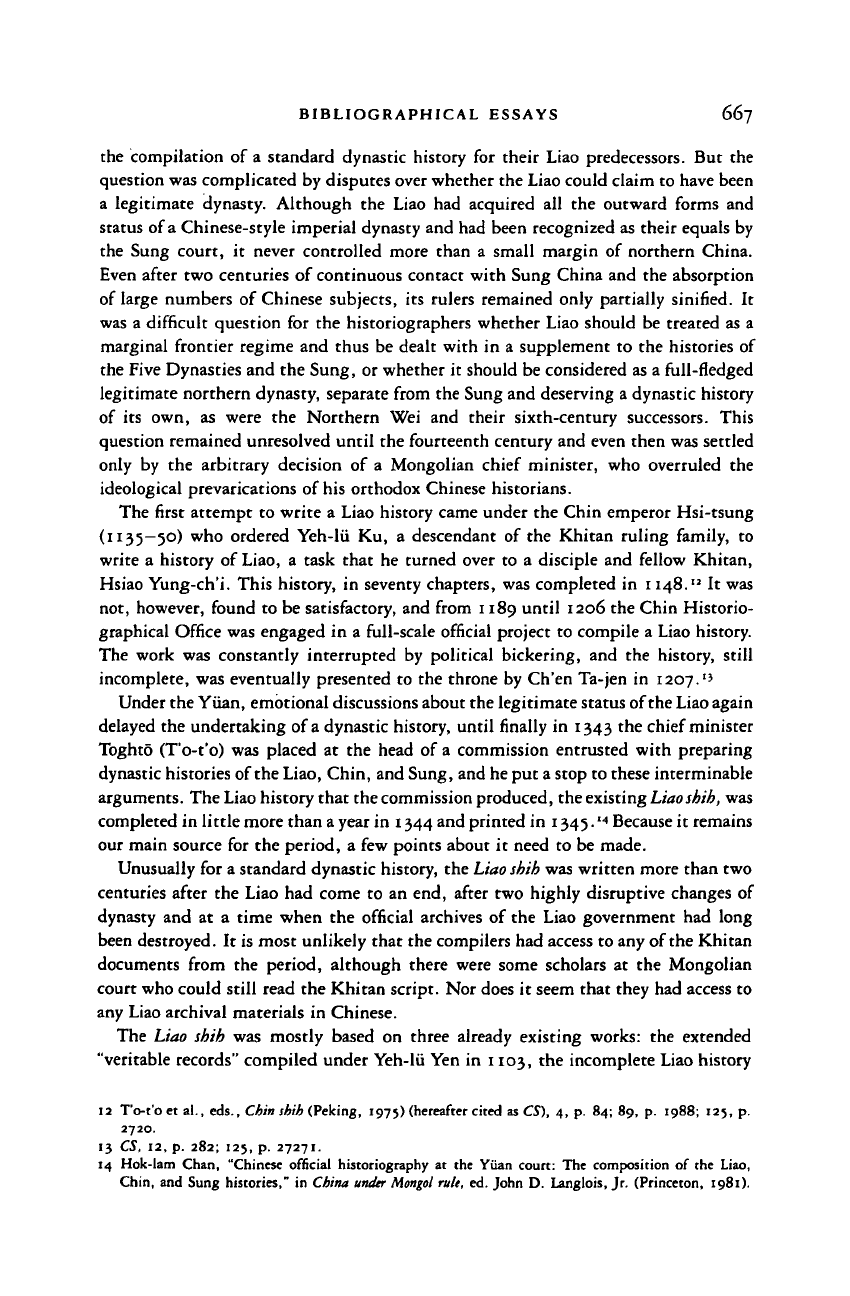
BIBLIOGRAPHICAL ESSAYS 667
the compilation of a standard dynastic history for their Liao predecessors. But the
question was complicated by disputes over whether the Liao could claim to have been
a legitimate dynasty. Although the Liao had acquired all the outward forms and
status of
a
Chinese-style imperial dynasty and had been recognized as their equals by
the Sung court, it never controlled more than a small margin of northern China.
Even after two centuries of continuous contact with Sung China and the absorption
of large numbers of Chinese subjects, its rulers remained only partially sinified. It
was a difficult question for the historiographers whether Liao should be treated as a
marginal frontier regime and thus be dealt with in a supplement to the histories of
the Five Dynasties and the Sung, or whether it should be considered as a full-fledged
legitimate northern dynasty, separate from the Sung and deserving a dynastic history
of its own, as were the Northern Wei and their sixth-century successors. This
question remained unresolved until the fourteenth century and even then was settled
only by the arbitrary decision of a Mongolian chief minister, who overruled the
ideological prevarications of his orthodox Chinese historians.
The first attempt to write a Liao history came under the Chin emperor Hsi-tsung
(1135-50) who ordered Yeh-lii Ku, a descendant of the Khitan ruling family, to
write a history of
Liao,
a task that he turned over to a disciple and fellow Khitan,
Hsiao Yung-ch'i. This history, in seventy chapters, was completed in 1148." It was
not, however, found to be satisfactory, and from 1189 until 1206 the Chin Historio-
graphical Office was engaged in a full-scale official project to compile a Liao history.
The work was constantly interrupted by political bickering, and the history, still
incomplete, was eventually presented to the throne by Ch'en Ta-jen in
1207.
•'
Under the Yuan, emotional discussions about the legitimate status of the
Liao
again
delayed the undertaking of
a
dynastic history, until finally in 1343 the chief minister
Toghto (T'o-t'o) was placed at the head of a commission entrusted with preparing
dynastic histories of
the
Liao,
Chin, and Sung, and he put a stop to these interminable
arguments. The
Liao
history that the commission produced, the existing
Liaoshih,
was
completed in little more than
a
year in 1344 and printed in
1345.
'
4
Because it remains
our main source for the period, a few points about it need to be made.
Unusually for a standard dynastic history, the
Liao shih
was written more than two
centuries after the Liao had come to an end, after two highly disruptive changes of
dynasty and at a time when the official archives of the Liao government had long
been destroyed. It is most unlikely that the compilers had access to any of
the
Khitan
documents from the period, although there were some scholars at the Mongolian
court who could still read the Khitan script. Nor does it seem that they had access to
any Liao archival materials in Chinese.
The Liao shih was mostly based on three already existing works: the extended
"veritable records" compiled under Yeh-lii Yen in 1103, the incomplete Liao history
12 T'o-t'o et al., eds., Chin shih (Peking, 1975) (hereafter cited as CS), 4, p. 84; 89, p. 1988; 125, p.
2720.
13 CS, 12, p. 282; 125, p. 27271.
14 Hok-lam Chan, "Chinese official historiography at the Yuan court: The composition of the Liao,
Chin, and Sung histories," in China under Mongol rule, ed. John D. Langlois, Jr. (Princeton, 1981).
Cambridge Histories Online © Cambridge University Press, 2008
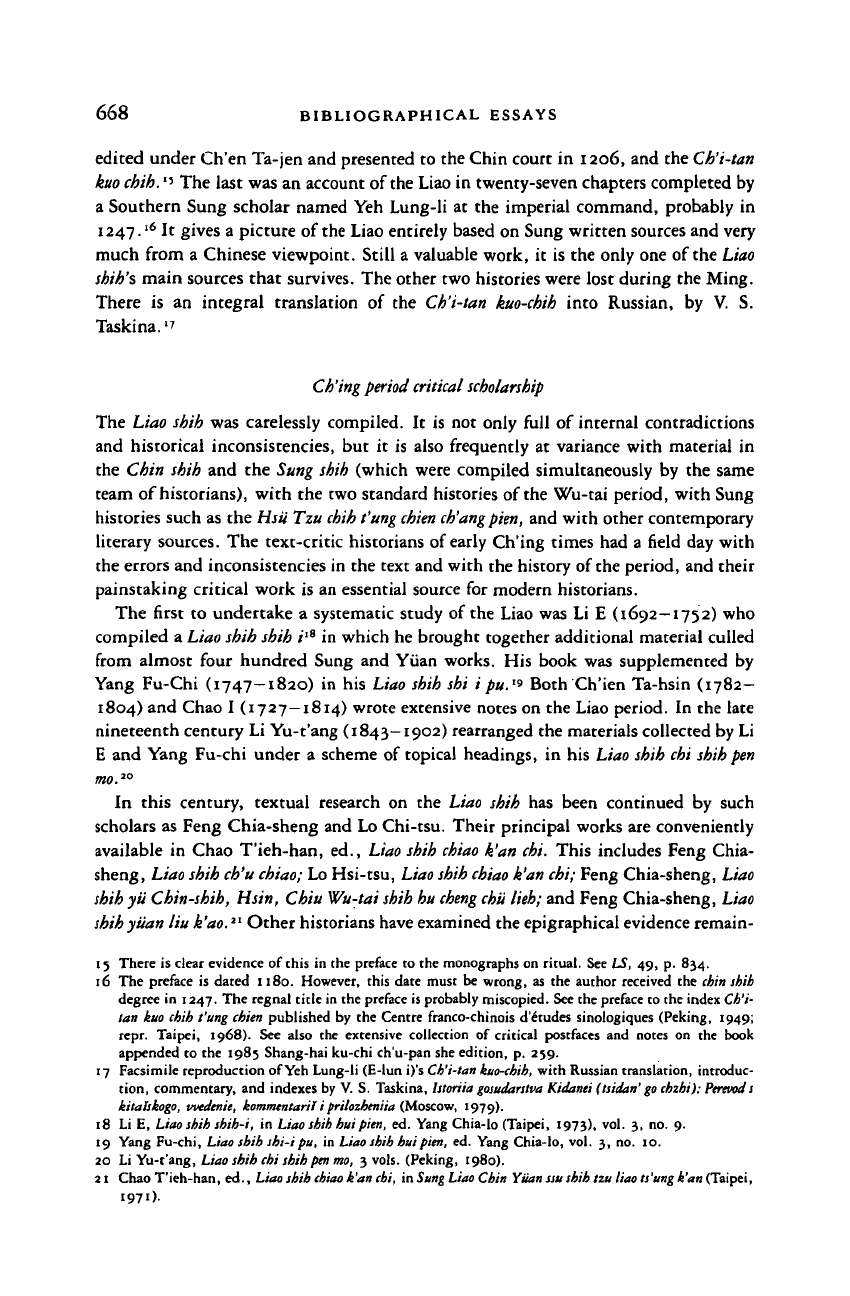
668 BIBLIOGRAPHICAL ESSAYS
edited under Ch'en Ta-jen and presented to the Chin court in 1206, and the
Ch'i-tan
kuo
chih.
•' The last was an account of
the
Liao in twenty-seven chapters completed by
a Southern Sung scholar named Yeh Lung-li at the imperial command, probably in
1247.
l6
It gives a picture of the Liao entirely based on Sung written sources and very
much from a Chinese viewpoint. Still a valuable work, it is the only one of the
Liao
sbih's
main sources that survives. The other two histories were lost during the Ming.
There is an integral translation of the Ch'i-tan
kuo-chih
into Russian, by V. S.
Taskina."
Ch'ing period critical scholarship
The Liao shih was carelessly compiled. It is not only full of internal contradictions
and historical inconsistencies, but it is also frequently at variance with material in
the Chin shih and the
Sung shih
(which were compiled simultaneously by the same
team of
historians),
with the two standard histories of the Wu-tai period, with Sung
histories such as the Hsu Tzu
chih
t'ung
chien
ch'angpien,
and with other contemporary
literary sources. The text-critic historians of early Ch'ing times had a field day with
the errors and inconsistencies in the text and with the history of the period, and their
painstaking critical work is an essential source for modern historians.
The first to undertake a systematic study of the Liao was Li E (1692—1752) who
compiled a
Liao shih shih
i'
8
in which he brought together additional material culled
from almost four hundred Sung and Yuan works. His book was supplemented by
Yang Fu-Chi (1747—1820) in his
Liao shih
shi i pu.'
9
Both Ch'ien Ta-hsin (1782—
1804) and Chao I (1727—1814) wrote extensive notes on the Liao period. In the late
nineteenth century Li Yu-t'ang (1843-1902) rearranged the materials collected by Li
E and Yang Fu-chi under a scheme of topical headings, in his
Liao shih chi shih pen
mo.
20
In this century, textual research on the Liao shih has been continued by such
scholars as Feng Chia-sheng and Lo Chi-tsu. Their principal works are conveniently
available in Chao T'ieh-han, ed.,
Liao shih chiao
k'an
chi.
This includes Feng Chia-
sheng, Liao shih ch'u
chiao;
Lo Hsi-tsu, Liao shih
chiao
k'an chi; Feng Chia-sheng, Liao
shih yii Chin-shih, Hsin, Chiu Wu-tai shih hu
cheng ch'u
lieh; and Feng Chia-sheng, Liao
shih yuan
liu
k'ao.
21
Other historians have examined the epigraphical evidence remain-
15 There is clear evidence of this in the preface to the monographs on ritual. See IS, 49, p. 834.
16 The preface is dated 1180. However, this date must be wrong, as the author received the chin shih
degree in 1247. The regnal title in the preface is probably miscopied. See the preface to the index Ch'i-
tan kuo chih t'ung chien published by the Centre franco-chinois d'lrudes sinologiques (Peking, 1949;
repr. Taipei, 1968). See also the extensive collection of critical postfaces and notes on the book
appended to the 198; Shang-hai ku-chi ch'u-pan she edition, p. 259.
17 Facsimile reproduction of Yeh Lung-li (E-lun O's Ch'i-tan
kuo-chih,
with Russian translation, introduc-
tion,
commentary, and indexes by V. S. Taskina, Utoriia
gosudarstva
Kidanei (tsidan'
go
chzhi): Pernods
kitalskogo, wedenie, kommtntaril i prilozheniia (Moscow, 1979).
18 Li E, Liao ihih shih-i, in Liao shih hui
pien,
ed. Yang Chia-lo (Taipei, 1973), vol. 3, no. 9.
19 Yang Fu-chi, Liao sbib shi-i pu, in Liao shih hui
pien,
ed. Yang Chia-lo, vol. 3, no. 10.
20 Li Yu-t'ang, Liao shih chi shih
pen
mo, 3 vols. (Peking, 1980).
21 Chao T'ieh-han, ed., Liao shih
chiao
k'an
chi,
in
Sung
Liao Chin Yuan
ssu
shih tzu liao
ts'ung
k'an (Taipei,
Cambridge Histories Online © Cambridge University Press, 2008
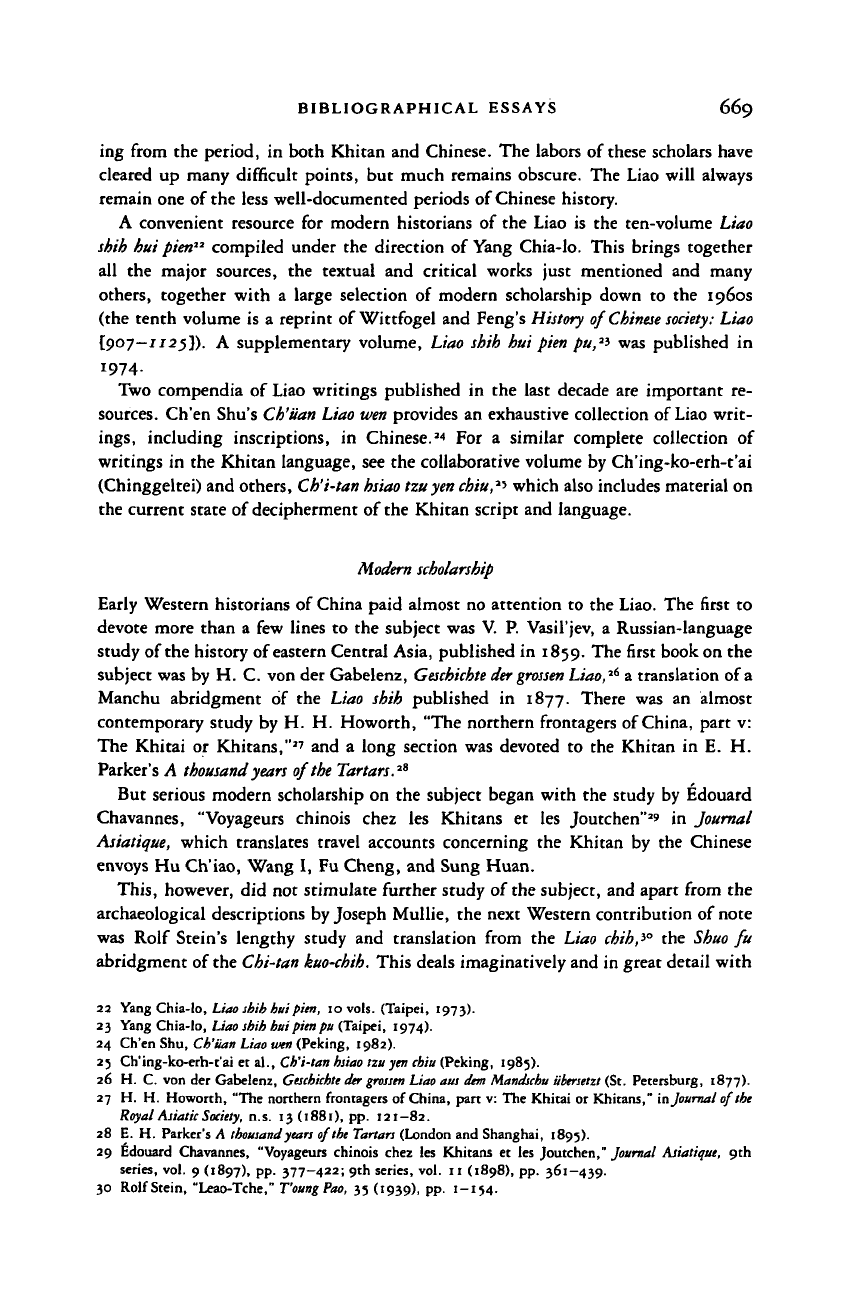
BIBLIOGRAPHICAL ESSAYS 669
ing from the period, in both Khitan and Chinese. The labors of these scholars have
cleared up many difficult points, but much remains obscure. The Liao will always
remain one of the less well-documented periods of
Chinese
history.
A convenient resource for modern historians of the Liao is the ten-volume Liao
shih
hui pien" compiled under the direction of Yang Chia-lo. This brings together
all the major sources, the textual and critical works just mentioned and many
others, together with a large selection of modern scholarship down to the 1960s
(the tenth volume is a reprint of Wittfogel and Feng's
History
of
Chinese
society:
Liao
[907—1125]). A supplementary volume, Liao shih hui
pien pu,
2
>
was published in
1974.
Two compendia of Liao writings published in the last decade are important re-
sources. Ch'en Shu's
Ch'iian Liao wen
provides an exhaustive collection of
Liao
writ-
ings,
including inscriptions, in Chinese.
34
For a similar complete collection of
writings in the Khitan language, see the collaborative volume by Ch'ing-ko-erh-t'ai
(Chinggeltei) and others,
Ch'i-tan hsiao
tzuyen chiu,^ which also includes material on
the current state of decipherment of the Khitan script and language.
Modern scholarship
Early Western historians of China paid almost no attention to the Liao. The first to
devote more than a few lines to the subject was V. P. Vasil'jev, a Russian-language
study of
the
history of eastern Central Asia, published in 1859. The first book on the
subject was by H. C. von der Gabelenz,
Geschichte
der
grvssen
Liao,*
6
a translation of a
Manchu abridgment of the Liao shih published in 1877. There was an almost
contemporary study by H. H. Howorth, "The northern frontagers of
China,
part v:
The Khitai or Khitans,"*
7
and a long section was devoted to the Khitan in E. H.
Parker's A thousand years of the
Tartars.**
But serious modern scholarship on the subject began with the study by Edouard
Chavannes, "Voyageurs chinois chez les Khitans et les Joutchen"
2
' in Journal
Asiatique, which translates travel accounts concerning the Khitan by the Chinese
envoys Hu Ch'iao, Wang I, Fu Cheng, and Sung Huan.
This,
however, did not stimulate further study of the subject, and apart from the
archaeological descriptions by Joseph Mullie, the next Western contribution of note
was Rolf Stein's lengthy study and translation from the Liao
chib,*°
the
Shuo
fu
abridgment of the
Chi-tan
kuo-chih.
This deals imaginatively and in great detail with
22 Yang Chia-lo, Liao shih hui
pien,
10 vols. (Taipei, 1973).
23 Yang Chia-lo, Liao shih
hui pien
pu (Taipei, 1974).
24 Ch'en Shu, Ch'iian Liao wen (Peking, 1982).
25 Ch'ing-ko-erh-t'ai et al., Ch'i-tan hsiao tzu yen
chiu
(Peking, 1985).
26 H. C. von der Gabelenz,
Ceschichte
der
grossen
Liao aus dan
Mandschu ubersetzt
(St. Petersburg, 1877).
27 H. H. Howorth, "The northern frontagers of China, part v: The Khitai or Khitans," in Journal of the
Royal Asiatic
Society,
n.s. 13 (1881), pp. 121-82.
28 E. H. Parker's A thousand years of
the
Tartars (London and Shanghai, 189;).
29 Edouard Chavannes, "Voyageurs chinois chez les Khitans et les Joutchen," Journal Asiatique, 9th
series,
vol. 9 (1897), pp. 377-422; 9th series, vol. 11 (1898), pp. 361-439.
30 Rolf Stein, "Leao-Tche,"
T'oung
Poo,
35 (1939), pp. 1—154.
Cambridge Histories Online © Cambridge University Press, 2008
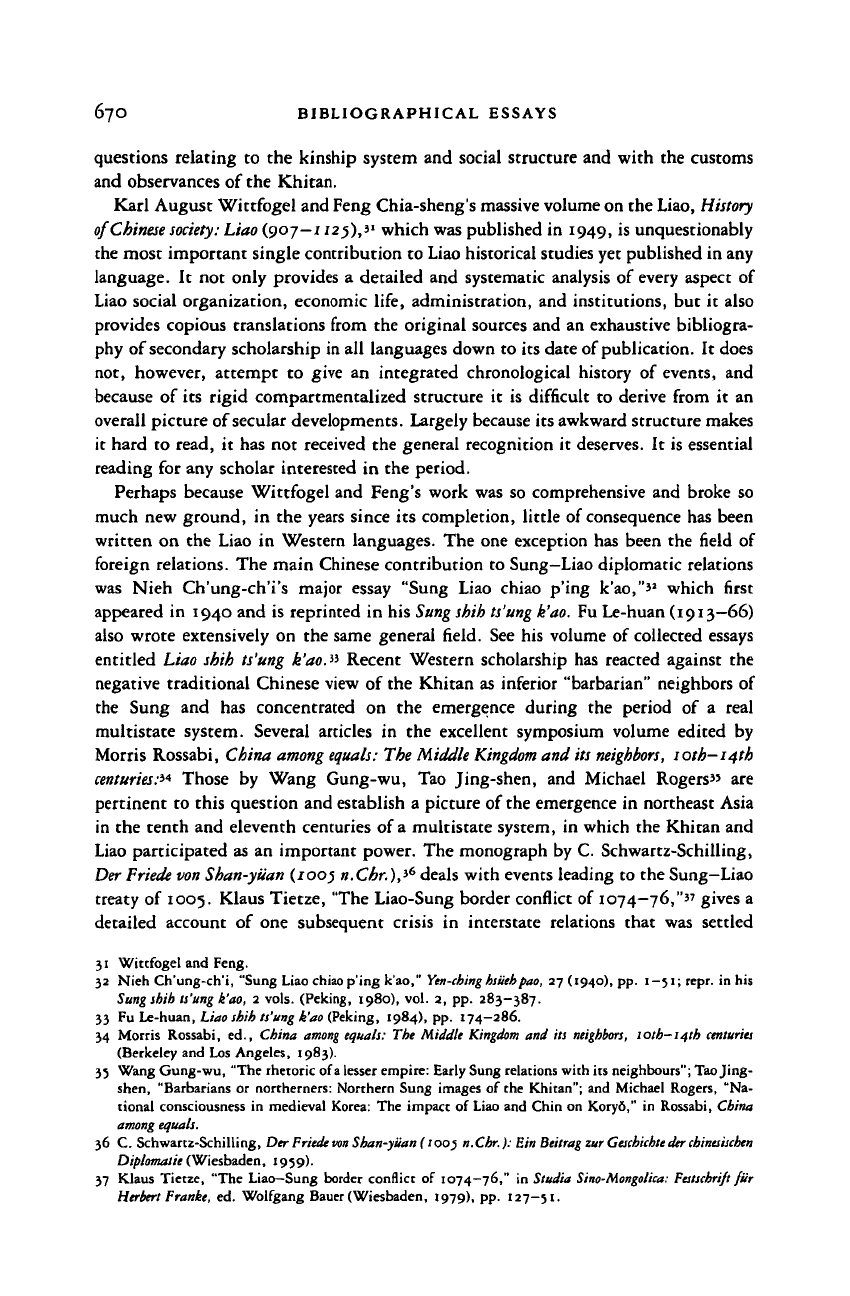
670 BIBLIOGRAPHICAL ESSAYS
questions relating to the kinship system and social structure and with the customs
and observances of the Khitan.
Karl August Wittfogel and Feng Chia-sheng's massive volume on the Liao,
History
of
Chinese
society:
Liao
(907—x
125),3
1
which was published in 1949, is unquestionably
the most important single contribution to Liao historical studies yet published in any
language. It not only provides a detailed and systematic analysis of every aspect of
Liao social organization, economic life, administration, and institutions, but it also
provides copious translations from the original sources and an exhaustive bibliogra-
phy of secondary scholarship in all languages down to its date of publication. It does
not, however, attempt to give an integrated chronological history of events, and
because of its rigid compartmentalized structure it is difficult to derive from it an
overall picture of secular developments. Largely because its awkward structure makes
it hard to read, it has not received the general recognition it deserves. It is essential
reading for any scholar interested in the period.
Perhaps because Wittfogel and Feng's work was so comprehensive and broke so
much new ground, in the years since its completion, little of consequence has been
written on the Liao in Western languages. The one exception has been the field of
foreign relations. The main Chinese contribution to Sung—Liao diplomatic relations
was Nieh Ch'ung-ch'i's major essay "Sung Liao chiao p'ing k'ao,"
3
* which first
appeared in 1940 and is reprinted in his
Sung shih ts'ung
k'ao.
Fu Le-huan (1913—66)
also wrote extensively on the same general field. See his volume of collected essays
entitled Liao shih
ts'ung
k'ao.» Recent Western scholarship has reacted against the
negative traditional Chinese view of the Khitan as inferior "barbarian" neighbors of
the Sung and has concentrated on the emergence during the period of a real
multistate system. Several articles in the excellent symposium volume edited by
Morris Rossabi,
China among
equals:
The Middle Kingdom
and
its
neighbors,
ioth-i4th
centuries:**
Those by Wang Gung-wu, Tao Jing-shen, and Michael Rogers'' are
pertinent to this question and establish a picture of the emergence in northeast Asia
in the tenth and eleventh centuries of
a
multistate system, in which the Khitan and
Liao participated as an important power. The monograph by C. Schwartz-Schilling,
Der Friede von Shan-yuan
(1005
n.Chr.),*
6
deals with events leading to the Sung—Liao
treaty of 1005. Klaus Tietze, "The Liao-Sung border conflict of 1074—76,"" gives a
detailed account of one subsequent crisis in interstate relations that was settled
31 Wittfogel and Feng.
32 Nieh Ch'ung-ch'i, "Sung Liao chiao p'ing k'ao,"
Yen-ching hsiieh
poo,
27 (1940), pp. i-5i;repr. in his
Sung shih ts'ung k'ao, 2 vols. (Peking, 1980), vol. 2, pp. 283—387.
33 Fu Le-huan, Liao shih ts'ung k'ao (Peking, 1984), pp. 174—286.
34 Morris Rossabi, ed., China
among
equals: The Middle Kingdom and its
neighbors,
loth-i^th
centuries
(Berkeley and Los Angeles, 1983).
3;
Wang Gung-wu, "The rhetoric of
a
lesser empire: Early Sung relations with its neighbours";
Tao
Jing-
shen, "Barbarians or northerners: Northern Sung images of the Khitan"; and Michael Rogers, "Na-
tional consciousness in medieval Korea: The impact of Liao and Chin on Koryd," in Rossabi, China
among equals.
36 C. Schwartz-Schilling, Dtr
Friede von
Shan-yuan (1005 n.Chr.): Ein Beitrag zur
Geschichte der chinesisehen
Diplomatic (Wiesbaden, 1939).
37 Klaus Tietze, "The Liao—Sung border conflict of 1074—76," in Studia
Sino-Mongolica:
Festschrift
fur
Herbert Franie, ed. Wolfgang Bauer (Wiesbaden, 1979), pp. 127-51.
Cambridge Histories Online © Cambridge University Press, 2008

BIBLIOGRAPHICAL ESSAYS 671
without hostilities. Dagmar Thiele, Der
Abschluss eines
Vertrages:
Diplomatic zwischen
Sung undChin Dynastie 1117—1123,1
s
gives a detailed account of the last years of the
dynasty, though its primary focus is on Sung-Chin relations rather than the Liao.
T'ao Ching-shen (T'ao Chin-sheng) presented a full account of Sung-Liao relations in
his
Sung—Liao
kuan hsi shihyen chiu.
i9
His English-language study of the same theme,
Two Sons
of Heaven,*
0
appeared after this chapter was completed.
Two recent Ph.D. theses, as yet unpublished, also deal with Liao foreign relations:
Janet Novey, "Yii Ching, a Northern Sung statesman, and his treatise on the Ch'i-tan
bureaucracy,"'
1
' and Melvin Thlick-len Ang, "Sung—Liao diplomacy in eleventh- and
twelfth-century China: A study of the social and political determinants of foreign
policy."
42
The latter is almost exclusively a study of the Sung officials appointed as
diplomatic envoys to Liao.
A number of significant works on Liao history have appeared in Chinese. The
rich and imaginative studies by Fu Le-huan, whose early death in 1966 was a major
loss to Liao studies, were reprinted in his posthumous Liao shih ts'ung k'ao.
Ai
The
most notable and prolific Liao historian in the People's Republic has been Ch'en
Shu, whose Ch'i-tan she hui ching chi shih ka&u is perhaps the most ambitious
attempt by a Chinese historian at analyzing Liao society and its economy. Its
analysis differs from that of Wittfogel and Feng and is at times somewhat more
systematic than the thin and fragmented evidence would seem to justify. It is also
static and gives little sense of secular change. Ch'en Shu's most recent book, Ch'i-
tan cheng chih shih kao," contains a series of interesting and sometimes original
essays on aspects of Khitan social and governmental institutions and on various
political incidents and issues. A general account written for a nonscholarly audience
is by Ch'en Shu, Liao-tai shih hua.<
6
Also of interest is Chang Chen-ming's Ch'i-tan
shih
lu'eh.*
1
A great part of this also deals with socioeconomic and institutional
matters, but it is more integrative and gives more of a sense of historical develop-
ment. A much more detailed and systematic treatment of Liao history is that by
Shu Fen, Liao shih kao,*
8
which was not available to me until after the completion
of this chapter.
Perhaps the best general outline of Liao political history is contained in a set of
detailed lecture notes by Yao Ts'ung-wu, posthumously published after his death in
38 Dagmar Thiele, Der
Abschluss eines
Vertrages:
Diplomatie
zwischen
Sung-und Chin Dynastie n 17—1123
(Wiesbaden, 1971).
39 T'ao Chin-sheng (Tao Jing-shen), Sung Liao kuan hsi shih
yen chiu
(Taipei, 1984).
40 T'ao Chin-sheng (Tao Jing-shen),
Two sons
of
heaven
(Tucson, 1988).
41 Janet Novey, "Yii Ching, a Northern Sung statesman, and his treatise on the Ch'i-tan bureaucracy,"
Ph.D.
diss., Indiana University, 1983.
42 Melvin Thlick-len Ang, "Sung-Liao diplomacy in eleventh- and twelfth-century China: A study of the
social and political determinants of foreign policy," Ph.D. diss., University of Pennsylvania, 1983.
43 Fu Le-huan, Liao shih ts'ung t'ao (Peking, 1984).
44 Ch'en Shu, Ch'i-tan
she
hui ching chi shih kao (Peking, Shang-hai, 1963; repr. 1978).
45 Ch'en Shu, Ch'i-tan
cheng chih
shih kao (Peking, 1986).
46 Ch'en Shu, Liao tai shih hua (Cheng-chou, 1981).
47 Chang Cheng-ming, Ch'i-tan shih liieh (Peking, 1979). According to the author's postface, this book
was actually completed around 1963.
48 Shu Fen, Liao shih kao (Wu-han, 1984).
Cambridge Histories Online © Cambridge University Press, 2008

672 BIBLIOGRAPHICAL ESSAYS
1971 and edited for publication with his collected writings by T'ao Chin-sheng.*
9
Professor Yao wrote several excellent studies of Liao political and institutional his-
tory, which are notable for both their imaginative understanding of complex events
and their scrupulous scholarship. The most important are included in his
Tung-pei
shih
lun
ts-ungS°
and they also are reprinted in
Liao shih hut pien
and its supplement.
Since the 1930s much of the best work on Liao history, and especially on its
society and legal institutions, has come from Japanese scholars. The most important
contributions are the series of exhaustive and systematic studies by Shimada Masao:
on the Liao law codes (with Takigawa Masajiro),
5
' Liao society,
52
the Liao govern-
ment institutions," Liao society and culture,'« the Liao bureaucratic system," and
various studies of
Liao
history.'
6
These studies are particularly thorough and detailed
in regard to legal and administrative institutions. Their conclusions on law are
summarized and further developed in a forthcoming study by Herbert Franke,
"Chinese law in a multinational society: The case of the Liao (907—1125),"" a paper
presented at the History of Chinese Medieval Law conference in Bellagio, Italy, in
1981.
The same author has also published an integral translation with full commen-
tary of the monograph on law from the
Liao
shih.^
Two interesting contributions to the study of Liao kinship were published by
Jennifer Holmgren: "Marriage, kinship and succession under the Ch'i-tan rulers of
the Liao dynasty (907—ii25)"'
9
and "Yeh-lii, Yao-lien and Ta-ho: Views of the
hereditary prerogative in early Khitan leadership."
60
On Liao Buddhism, the best account is still that in Nogami Shunjo,
Ryo
Kin
no
Bukkyo.
6l
On Liao material culture, the first important evidence came from archaeology,
especially from the excavation of the Liao imperial tombs. Joseph Mullie, "Les
anciennes villes de l'empire des grands Leao au Royaume mongol de Barin"
6
* and
"Les sepultures de K'ing des Leao,"
6
' first drew the attention of Western readers to
49 Yao Ts'ung-wu, "Liao Chin Yuan shih chiang-i (chia): Liao ch'ao shih," in Yao
Ts'ung-wu bsien-sheng
ch'iian-chi,
comp. T'ao Chin-sheng (Taipei, 1972), vol. 2.
50 Yao Ts'ung-wu,
Tung-pei
shib lun
Is'ung,
2 vols. (Taipei, 1959); repr. in Yang Chia-lo, Liao sbih huipien
(Taipei, 1973).
51 Takigawa Masajiro and Shimada Masao, Ryoritsu
no
kenkyu (Tokyo, 1943).
52 Shimada Masao, Ryodaishakaishikmkyi (Kyoto, 1952).
53 Shimada Masao, Ry
osei
no kenkyu (Tokyo, 1954; repr. Tokyo, 1973).
54 Shimada Masao, Ryo
no
shakai to
bunka
(Tokyo, 1956).
55 Shimada Masao,
Ryocho
kanset
no kenkyu
(Tokyo, 1978).
56 Shimada Masao,
Ryochoshi
no
kenkyu
(Tokyo, 1979).
57 Herbert Franke, "Chinese law in a multinational society: The case of the Liao (907—1125)," paper
presented at the History of Chinese Medieval Law Conference, Bellagio, Italy, 1981.
58 Herbert Franke, "The "Treatise on punishments' in the Liao history," Central Asiatic Journal (1983),
pp.
9-38.
59 Jennifer Holmgren, "Marriage, kinship and succession under the Ch'i-tan rulers of the Liao dynasty
(907—1125),"
T'oung
Pao, 72 (1986), pp. 44—91.
60 Jennifer Holmgren, "Yeh-lii, Yao-lien and Ta-ho: Views of the hereditary prerogative in early Khitan
leadership,"
Papers
on Far
Eastern
History, 34 (Canberra, 1986), pp. 37—81.
61 Nogami Shunjo, Ryo Kin no
Bukkyo
(Kyoto, 1953).
62 Joseph Mullie, "Les anciennes villes de
l'empire
des grands Leao au Royaume mongol de Barin,"
T'oung
Pao, 21 (1922), pp. 105-231.
63 Joseph Mullie, "Les sepultures de
K'ing
des Leao,"
T'oung
Pao, 30 (1933), PP-
I-2
5-
Cambridge Histories Online © Cambridge University Press, 2008
